MERCEDES-BENZ CLA COUPE 2018 Workshop Manual
Manufacturer: MERCEDES-BENZ, Model Year: 2018, Model line: CLA COUPE, Model: MERCEDES-BENZ CLA COUPE 2018Pages: 326, PDF Size: 5.59 MB
Page 51 of 326
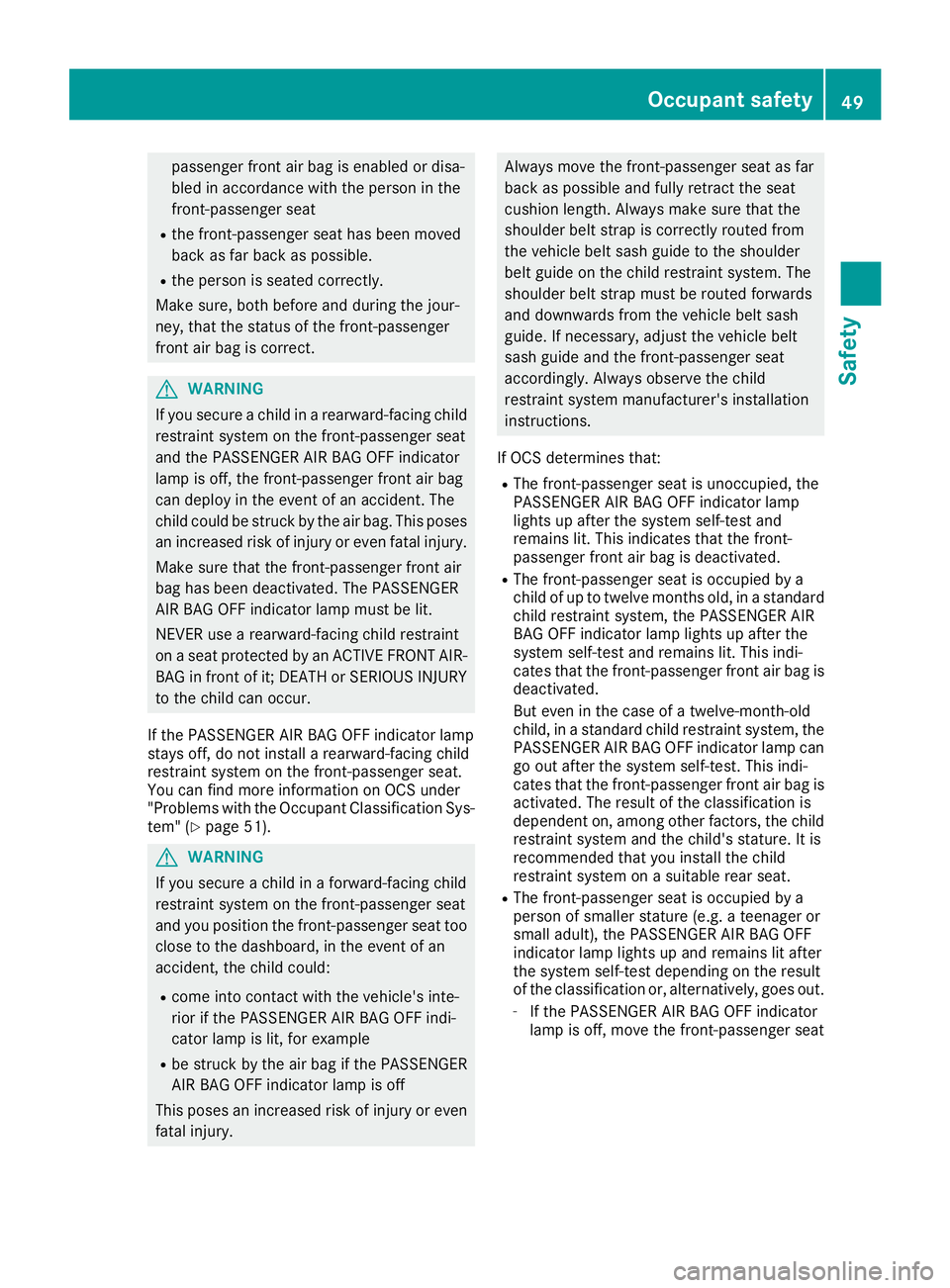
passenger frontair bag is enabled or disa-
bled in accordance with the person in the
front-passenger seat
Rthe front-passenger seat has been moved
back as far back as possible.
Rthe person is seated correctly.
Make sure, both before and during the jour-
ney, that the status of the front-passenger
fronta ir bag is correct.
GWARNING
If you secure achild in arearward-facing child
restraint system on the front-passenger seat
and the PASSENGER AIR BAGO FF indicator
lamp is off, the front-passenger fronta ir bag
can deploy in the event of an accident. The
child could be struck by the air bag. This poses an increased risk of injury or even fatal injury.
Make sure that the front-passenger fronta ir
bag has been deactivated. The PASSENGER
AIR BAGO FF indicator lamp must be lit.
NEVER use arearward-facing child restraint
on aseat protected by an ACTIVE FRONT AIR-
BAGinf rontofit; DEATH or SERIOUS INJURY
to the child can occur.
If the PASSENGER AIR BAGO FF indicator lamp
stays off, do not install arearward-facing child
restraint system on the front-passenger seat.
You can find more information on OCS under
"Problems with the Occupant Classification Sys-
tem" (
Ypage 51).
GWARNING
If you secure achild in aforward-facingc hild
restraint system on the front-passenger seat
and you position the front-passenger seat too close to the dashboard, in the event of an
accident, the child could:
Rcome int ocontact with the vehicle's inte-
rior if the PASSENGER AIR BAGO FF indi-
cator lamp is lit, for example
Rbe struck by the air bag if the PASSENGER
AIR BAGO FF indicator lamp is off
This poses an increased risk of injury or even fatal injury.
Always move the front-passenger seat as far
back as possible and fully retract the seat
cushion length. Always make sure that the
shoulder belt strap is correctly routed from
the vehicle belt sash guide to the shoulder
belt guide on the child restraint system. The
shoulder belt strap must be routed forwards
and downwards from the vehicle belt sash
guide. If necessary, adjust the vehicle belt
sash guide and the front-passenger seat
accordingly. Always observe the child
restraint system manufacturer's installation
instructions.
If OCS determines that:
RThe front-passenger seat is unoccupied, the
PASSENGER AIR BAGO FF indicator lamp
lights up after the system self-test and
remains lit. This indicates that the front-
passenger fronta ir bag is deactivated.
RThe front-passenger seat is occupied by a
child of up to twelve months old, in astandard
child restraint system, the PASSENGER AIR
BAGO FF indicator lamp lights up after the
system self-test and remains lit. This indi-
cates that the front-passenger fronta ir bag is
deactivated.
But even in the case of atwelve-month-old
child, in astandard child restraint system, the
PASSENGER AIR BAGO FF indicator lamp can
go out after the system self-test. This indi-
cates that the front-passenger fronta ir bag is
activated. The result of the classification is
dependen ton, among other factors, the child
restraint system and the child's stature. It is
recommended that you install the child
restraint system on asuitable rear seat.
RThe front-passenger seat is occupied by a
person of smaller stature (e.g. ateenager or
small adult), the PASSENGER AIR BAGO FF
indicator lamp lights up and remains lit after
the system self-test dependin gonthe result
of the classification or, alternatively, goes out.
-If the PASSENGER AIR BAGO FF indicator
lamp is off, move the front-passenger seat
Occupant safety49
Safety
Z
Page 52 of 326
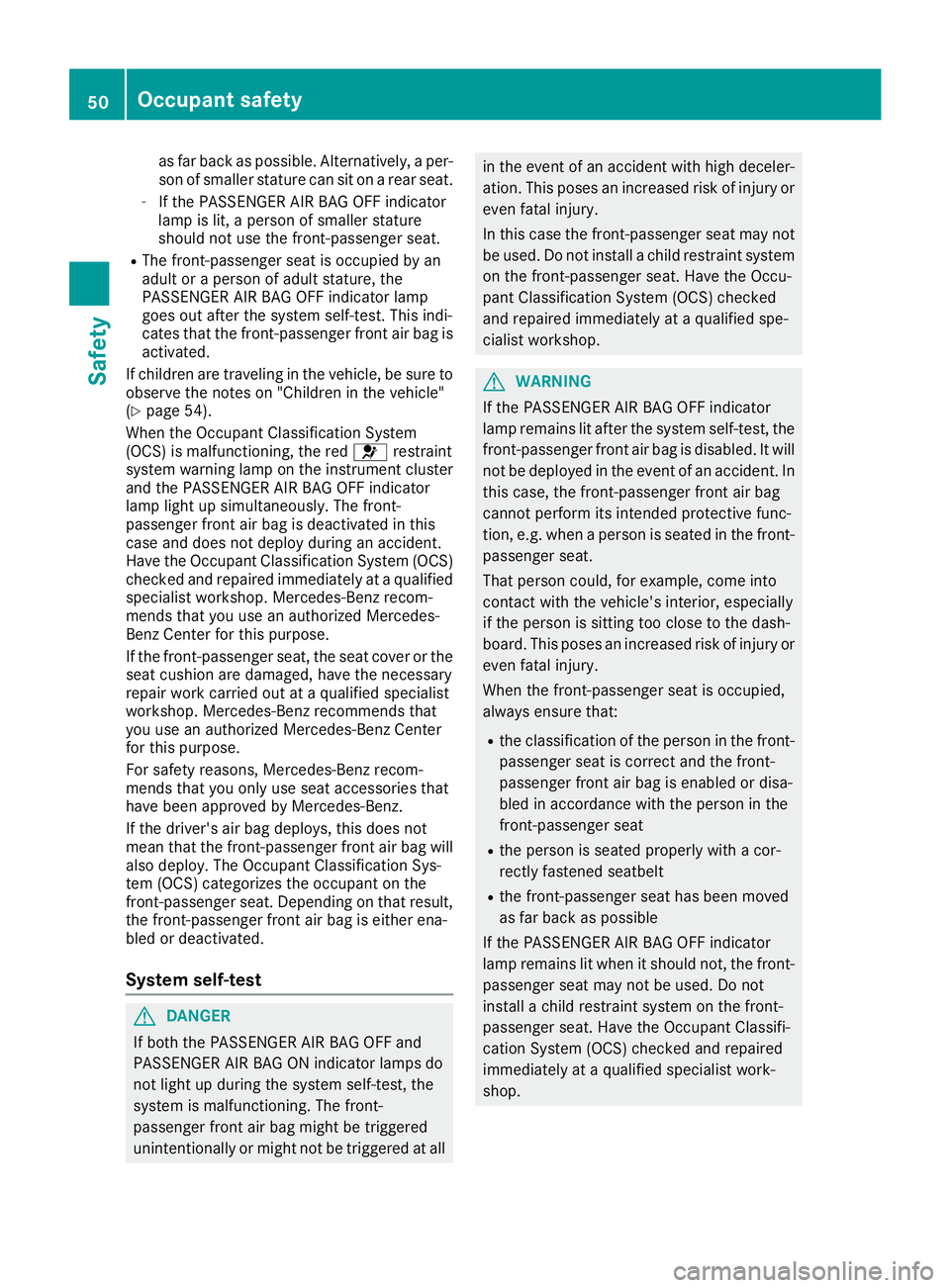
as far back as possible. Alternatively,aper-
son of smaller statur ecan sit on arear seat.
-If th ePASSENG ER AIRBAG OFFi ndicator
lamp is lit,ap erson of smaller stature
shouldn otuse th efront-pa ssenger seat.
RThe front-passenger seat is occupied by an
adult or aperson of adult stature, the
PASSENGER AI RBAG OFFi ndicator lamp
goes out after th esystem self-test.T his indi-
cates that th efront-pa ssenger fronta ir bag is
activated.
If childrena re travelinginthevehicle ,besure to
observ ethe note son" Children in th evehicle"
(
Ypage 54).
When th eOccupan tClassification System
(OCS)ism alfunctioning, th ered 6 restraint
system warning lamp on th einstrumentc luster
and th ePASSENG ER AIRBAG OFFi ndicator
lamp light up simultaneously. The front-
passenger fronta ir bag is deactivate dinthis
cas eand does no tdeployd uringana ccident.
Hav ethe Occupan tClassification System (OCS)
checked and repaired immediately at aqualified
specialist workshop.M ercedes-Benzrecom-
mends that you use an authorized Mercedes-
Ben zCenter for this purpose.
If th efront-pa ssenger seat,t heseat cover or the
seat cushion are damaged, have th enecessary
repai rwork carried out at aqualified specialist
workshop.M ercedes-Benzrecommend sthat
you use an authorized Mercedes-Ben zC
en
ter
for this purpose.
For safety reasons, Mercedes-Ben zrecom-
mends that you only use seat accessories that
have been approved by Mercedes-Benz.
If th edriver'sa ir bag deploys, this does not
mean that th efront-pa ssenger fronta ir bag will
also deploy. The Occupan tClassification Sys-
te m( OCS)c ategorize sthe occupant on the
front-passenger seat.D ependingont hatresult,
th ef ront-pa ssenger fronta ir bag is either ena-
bled or deactivated.
System self-test
GDANGER
If botht hePASSENGER AI RBAG OFFa nd
PASSENGER AI RBAG ON indicator lamps do
no tlight up durin gthe system self-test,t he
system is malfunctioning. The front-
passenger fronta ir bag mightbetriggered
unintentionally or mightn otbe triggered at all
in th eeven tofana ccidentw ith high deceler-
ation. This posesani ncreased risk of injury or
even fatal injury.
In this cas ethe front-passenger seat may not
be used. Do no tinstall achild restraint system
on th efront-pa ssenger seat.H avet he Occu-
pant Classification System (OCS)c hecked
and repaired immediately at aqualified spe-
cialis tworkshop.
GWARNING
If th ePASSENG ER AIRBAG OFFi ndicator
lamp remains lit after th esystem self-test,t he
front-passenger fronta ir bag is disabled. It will
no tbed eployed in th eeven tofana ccident. In
this case, th efront-pa ssenger fronta ir bag
canno tperform its intended protective func-
tion, e.g .when aperson is seated in th efront -
passenger seat.
That person could, for example, com einto
contac twith th evehicle's interior, especially
if th eperson is sittin gtoo close to th edash-
board .This posesani ncreased risk of injury or
even fatal injury.
When th efront-pa ssenger seat is occupied,
always ensure that:
Rth ec lassification of th eperson in th efront -
passenger seat is correc tand th efront -
passenger fronta ir bag is enabled or disa-
bled in accordance with th eperson in the
front-passenger seat
Rth ep erson is seated properly with acor-
rectly fastene dseatbelt
Rthef ront-pa ssenger seat has been moved
as far back as possible
If th ePASSENG ER AIRBAG OFFi ndicator
lamp remains lit when it shouldn ot,the front-
passenger seat may no tbeused. Do not
install achild restraint system on th efront -
passenger seat.H avet he Occupan tClassifi-
cation System (OCS)c hecked and repaired
immediately at aqualified specialist work-
shop.
50Occupant safety
Safety
Page 53 of 326
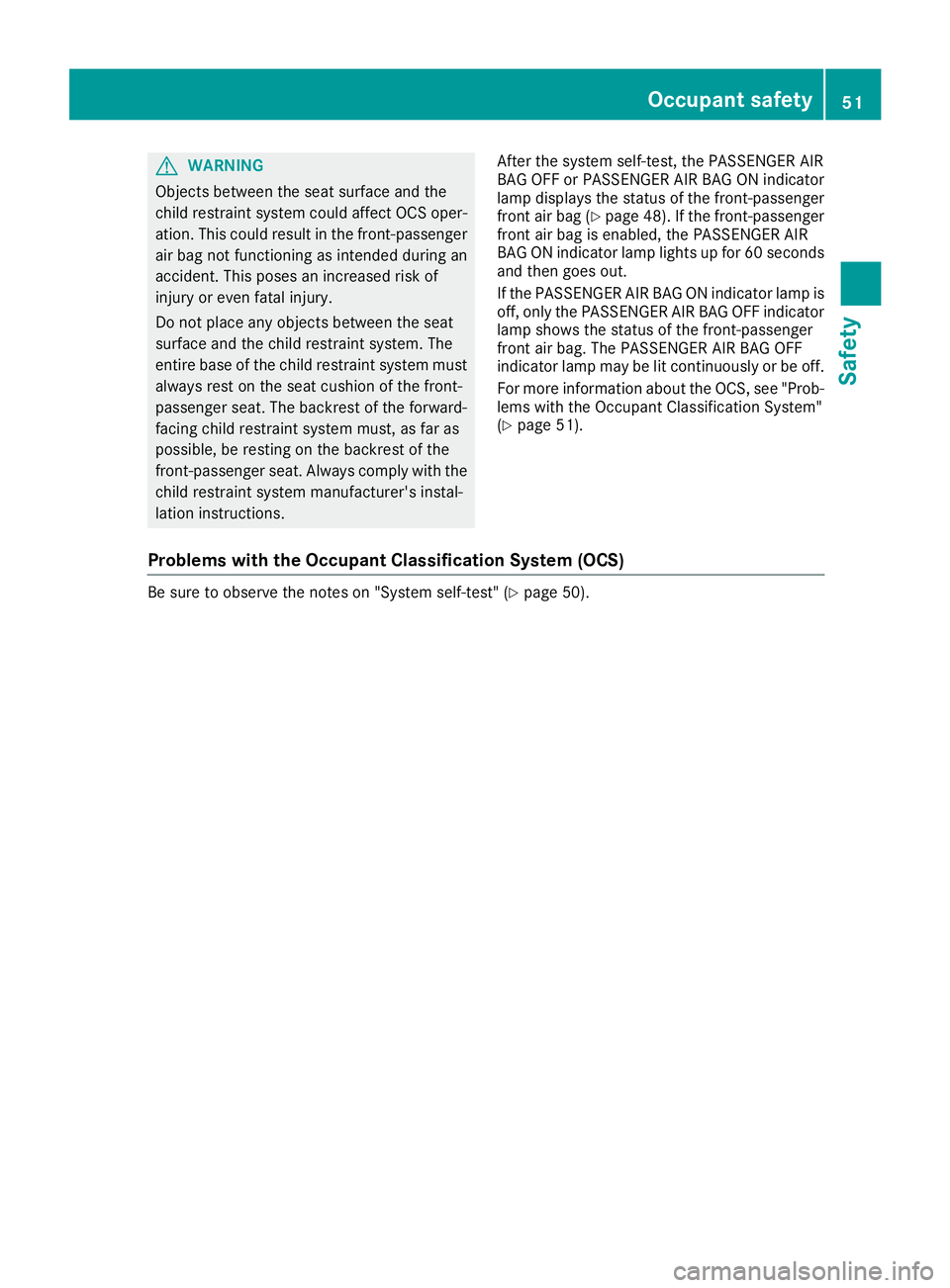
GWARNING
Objects between the seat surface and the
child restraint system coul daffect OCS oper-
ation. This coul dresult in the front-passenger
air bag not functioning as intended during an
accident. This poses an increased risk of
injury or even fatal injury.
Do not place any objects between the seat
surface and the child restraint system. The
entire base of the child restraint system must
alway srest on the seat cushion of the front-
passenger seat. The backrest of the forward-
facing child restraint system must, as far as
possible,ber esting on the backrest of the
front-passenge rseat. Always comply with the
child restraint system manufacturer's instal-
lation instructions. After the system self-test, the PASSENGER AIR
BAG OFF or PASSENGER AIR BAG ON indicator
lamp display
sthe status of the front-passenger
front air bag (
Ypage4 8). If the front-passenger
front air bag is enabled, the PASSENGER AIR
BAG ON indicator lamp lights up for 60 seconds and then goes out.
If the PASSENGER AIR BAG ON indicator lamp is
off, only the PASSENGER AIR BAG OFF indicator
lamp showst he status of the front-passenger
front air bag.T he PASSENGER AIR BAG OFF
indicator lamp may be lit continuously or be off.
For more information about the OCS, see "Prob-
lems with the Occupant Classification System"
(
Ypage5 1).
Problems with the Occupant Classificatio nSystem (OCS)
Be sure to observe the notes on "System self-test" (Ypag e50).
Occupant safety51
Safety
Z
Page 54 of 326
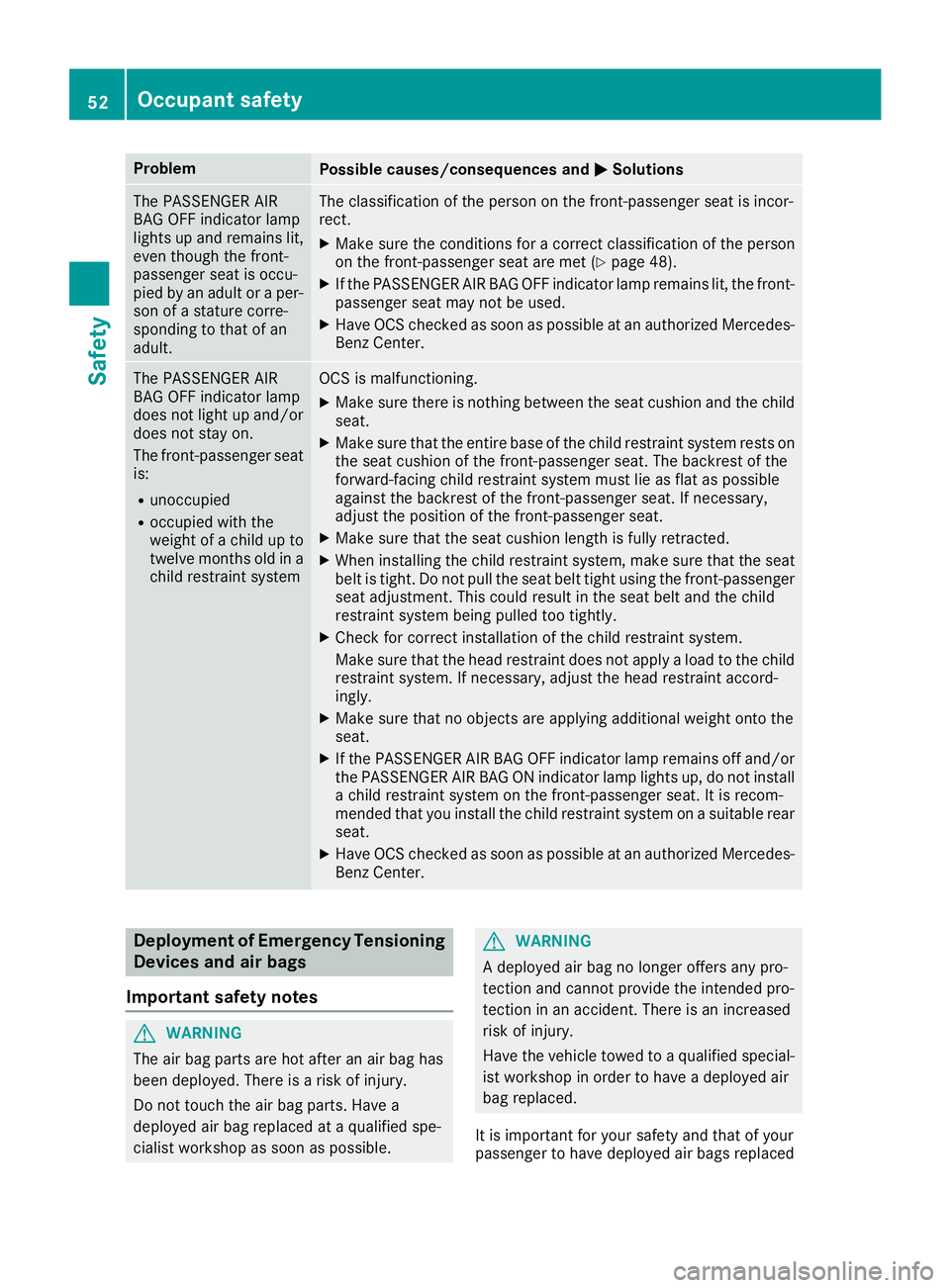
ProblemPossible causes/consequences andMSolutions
The PASSENGER AIR
BAG OFF indicator lamp
lights up and remains lit,
even though the front-
passenger seat is occu-
pied by an adult oraper-
son of astature corre-
sponding to that of an
adult.The classification of the person on the front-passenger seat is incor-
rect.
XMake sure the conditionsf orac orrect classification of the person
on the front-passenger seat are met (Ypage 48).
XIf the PASSENGER AIR BAG OFF indicator lamp remains lit, the front-
passenger seat may not be used.
XHave OCS checked as soon as possible at an authorized Mercedes- Benz Center.
The PASSENGER AIR
BAG OFF indicator lamp
does not light up and/or
does not stay on.
The front-passenger seat
is:
Runoccupied
Roccupied with the
weight of achild up to
twelve months old in a
child restraint system
OCS is malfunctioning.
XMake sure there is nothin gbetween the seat cushion and the child
seat.
XMake sure that the entire base of the child restraint system rests on
the seat cushion of the front-passenger seat. The backrest of the
forward-facing child restraint system must lie as flat as possible
against the backrest of the front-passenger seat. If necessary,
adjust the position of the front-passenger seat.
XMake sure that the seat cushion length is fully retracted.
XWhen installing the child restraint system, make sure that the seat
belt is tight. Do not pull the seat belt tight using the front-passenger seat adjustment .This could result in the seat belt and the child
restraint system being pulled too tightly.
XCheck for correct installation of the child restraint system.
Make sure that the head restraint does not apply aload to the child
restraint system. If necessary, adjust the head restraint accord-
ingly.
XMake sure that no object sare applying additional weight onto the
seat.
XIf the PASSENGER AIR BAG OFF indicator lamp remains off and/or
the PASSENGER AIR BAG ON indicator lamp lights up, do not install ac hild restraint system on the front-passenger seat. It is recom-
mended that you install the child restraint system on asuitable rear
seat.
XHave OCS checked as soon as possible at an authorized Mercedes- Benz Center.
Deployment of Emergency Tensioning
Devices and air bags
Important safety notes
GWARNING
The air bag parts are hot after an air bag has
been deployed. There is arisk of injury.
Do not touch the air bag parts. Have a
deployeda ir bag replaced at aqualified spe-
cialist workshop as soon as possible.
GWARNING
Ad eployeda ir bag no longer offers any pro-
tection and cannot provide the intended pro-
tection in an accident. There is an increased
risk of injury.
Have the vehicle towed to aqualified special-
ist workshop in order to have adeployeda ir
bag replaced.
It is important for your safety and that of your
passenger to have deployeda ir bags replaced
52Occupant safety
Safety
Page 55 of 326
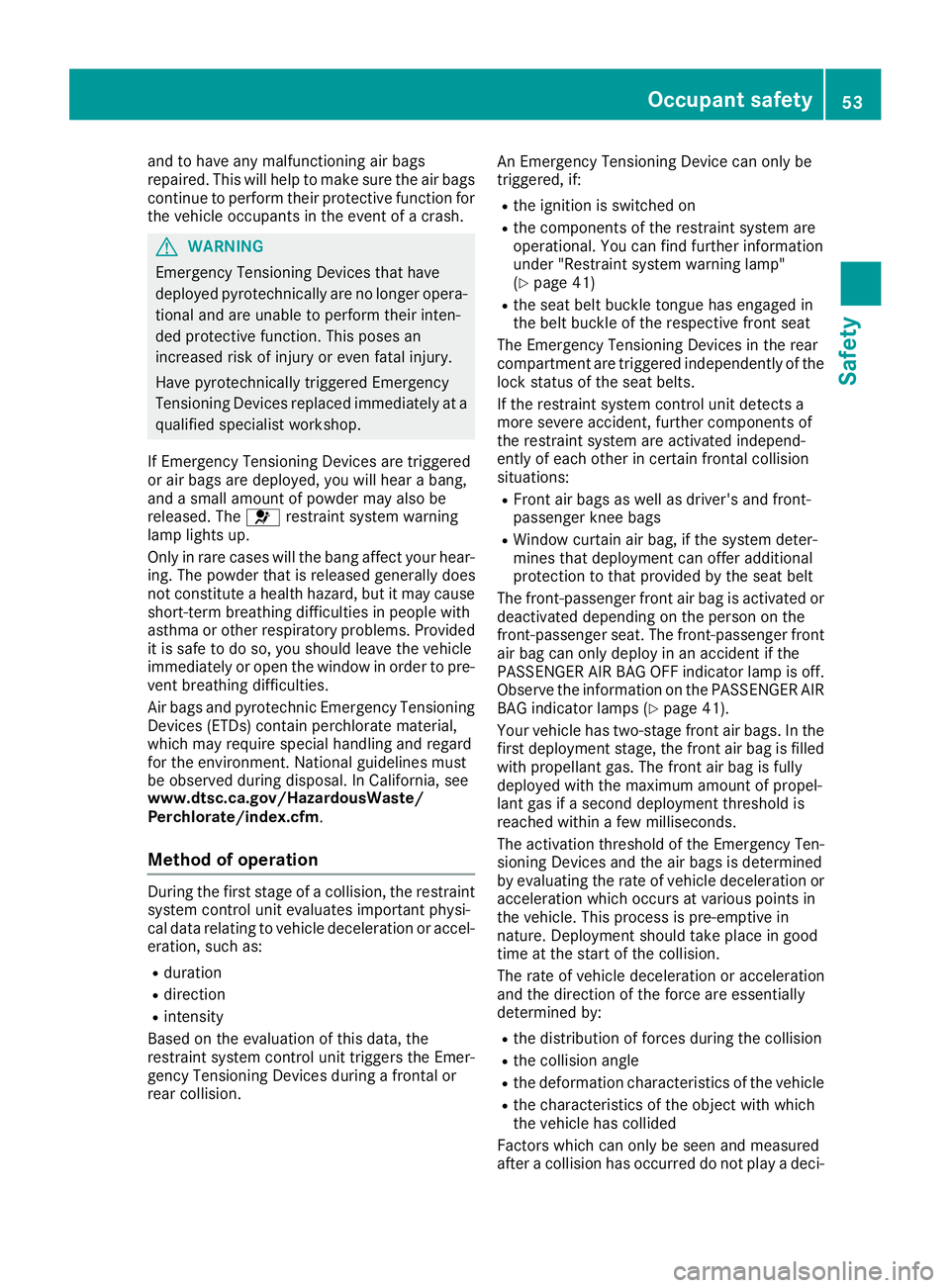
and to have any malfunctioningair bags
repaired. This will help to makes ure theair bags
continue to perform their protective function for
th ev ehicle occupant sintheeventofac rash.
GWARNING
Emergenc yTensioning Devices that have
deployed pyrotechnically are no longer opera-
tional and are unabl etoperform their inten-
ded protective function.T his posesan
increased risk of injury or even fatal injury.
Hav epyrotechnically triggered Emergency
Tensioning Devices replaced immediately at a
qualified specialist workshop.
If Emergenc yTensioning Devices are triggered
or air bags are deployed, you will hear abang,
and asmall amountofp owder may also be
released. The 6restraint system warning
lamp lightsu p.
Only in rar ecases will th ebang affect your hear-
ing .The powder that is released generally does
no tconstitut eahealthh azard, but it may cause
short-term breathingd ifficulties in peoplewith
asthma or other respiratory problems.P rovided
it is safe to do so, you shouldl eave thevehicle
immediately or open th ewindow in orde rtopre-
ven tbreathingd ifficulties.
Air bags and pyrotechnic Emergenc yTensioning
Devices (ETDs )contain perchlorate material,
whichm ay require special handlinga nd regard
for th eenvironment. National guidelines must
be observed durin gdisposal. In California, see
www.dtsc.ca.gov/HazardousWaste/
Perchlorate/index.cfm .
Method of operation
During thefirst stage of acollision,t herestraint
system control unit evaluates important physi-
cal datar elating to vehicle deceleratio noraccel-
eration,s uchas:
Rduration
Rdirection
Rintensity
Based on th eevaluation of this data, the
restraint system control unit triggerst heEmer-
gency Tensioning Devices durin gafrontal or
rear collision. An Emergenc
yTensioning Devic ecan only be
triggered, if:
Rth ei gnition is switched on
Rthec omponent softherestraint system are
operational. You can fin dfurther information
unde r"Restrain tsystem warning lamp"
(
Ypage 41)
Rth es eat belt buckle tongue has engaged in
th eb elt buckle of th erespectiv efront seat
The Emergenc yTensioning Devices in th erear
compartmenta re triggered independently of the
locks tatus of th eseat belts.
If th erestraint system control unit detect sa
mores evere accident, further component sof
th er estraint system are activated independ-
ently of each other in certain frontal collision
situations:
RFronta ir bags as well as driver'sa nd front-
passenger knee bags
RWindow curtain air bag, if th esystem deter-
mines that deploymen tcan offer additional
protection to that provided by th eseat belt
The front-passenger fronta ir bag is activated or
deactivate ddependingont he
person on t
he
front-passenger seat.T he front-passenger front
air bag can only deployinana ccidentifthe
PASSENGER AI RBAG OFFi ndicator lamp is off.
Observ ethe informatio nonthePASSENGER AIR
BA Gindicator lamps (
Ypage 41).
Your vehicle has two-stag efront air bags. In the
first deploymen tstage, th efront air bag is filled
with propellantg as. The frontair bag is fully
deployed with th emaximum amountofp ropel-
lant gas if asecondd eploymen tthreshold is
reached within afew milliseconds.
The activation threshold of th eEme rgenc yTen-
sioning Devices and th eair bags is determined
by evaluating th erateofv ehicle deceleratio nor
acceleratio nwhicho ccurs at various points in
th ev ehicle .This process is pre-emptive in
nature. Deployment shouldt akep lace in good
tim eatt hestart of th ecollision.
The rat eofvehicle deceleratio noracceleration
and th edirection of th eforce are essentially
determine dby:
Rthed istribution of forces durin gthe collision
Rthec ollision angle
Rthed eformatio ncharacteristics of th evehicle
Rthec haracteristics of th eobject with which
th ev ehicle has collided
Factors whichc an only be seen and measured
after acollision has occurre ddonotplay adeci-
Occupant safety53
Safety
Z
Page 56 of 326

sive role in the deployment of an air bag. Nor do
they provide an indication of air bag deploy-
ment.
The vehicle can be deformed considerably, with-
out an air bag being deployed. This is the case if only parts which are relatively easilyd eformed
are affected and the rate of deceleration is not
high. Conversely, air bags may be deployed even
though the vehicle suffers only minor deforma-
tion. This is the case if, for example, very rigid
vehicle parts such as longitudinal body mem-
bers are hit, and sufficient deceleration occurs
as aresult.
If the restraint system control unit detects aside
impact or if the vehicle rolls over, the applicable
componentsoft he restraint system are activa-
ted independently of each other depending on
the apparent type of accident.
RSide impact air bags on the side where the
impact takes place, independently of the
EmergencyT ensioning Device and the use of
the seat belt on the driver's seat and outer
seats in the second row
The side impact air bag on the front-
passenger side deploysu nder the following
conditions:
-the OCS system detects that the front-
passenger seat is occupied or
-the seat belt buckle tongue is engaged in
the belt buckle of the front-passenger seat
RWindow curtain air bag on the side of impact, independently of the use of the seat belt and
independently of whether the front-
passenger seat is occupied
REmergencyT ensioning Devices, if the system
determines that deployment can offer addi-
tional protection in this situation
RWindow curtain air bags on the driver's and
front-passenger side in certain situations
when the vehicle rolls over, if the system
determines that deployment can offer addi-
tional protection to that provided by the seat
belt
iNot all air bags are deployed in an accident.
The different air bag systems work independ- ently of each other. How the air bag system works is determined
by the severity of the accident detected,
especially the vehicle deceleration or accel-
eration and the apparent type of accident:
RFrontal collision
RSide impact
RRollover
Automatic measures after an acci-
dent
Immediately after an accident, the following
measures are implemented, depending on the
type and severity of the impact:
Rthe hazard warning lamps are activated
Rthe emergency lighting is activated
Rthe vehicle doors are unlocked
Rthe front side windows are lowered
Rthe engine is switched off and the fuel supply
is cut off
Rvehicles with mbrace: automatic emergency
call
Children in the vehicle
Important safety notes
Accident statistics show that children secured
in the rear seats are safer than children secured
in the front-passenger seat. For this reason,
Mercedes-Benz strongly advises that you install
ac hild restraint system on arear seat. Children
are generally better protected there.
If ac hild younger than twelve years old and
under 5ft(1.50 m) in height is traveling in the
vehicle:
Ralways secure the child in achild restraint
system suitable for Mercedes-Benz vehicles.
The child restraint system must be appropri-
ate to the age, weight and size of the child
Rbe sure to observe the instructions and safety
notes in this section in addition to the child
restraint system manufacturer's installation
instructions
Rbe sure to observe the instructions and safety notes on the "Occupant classification system
(OCS)" (
Ypage 47)
54Children in the vehicle
Safety
Page 57 of 326
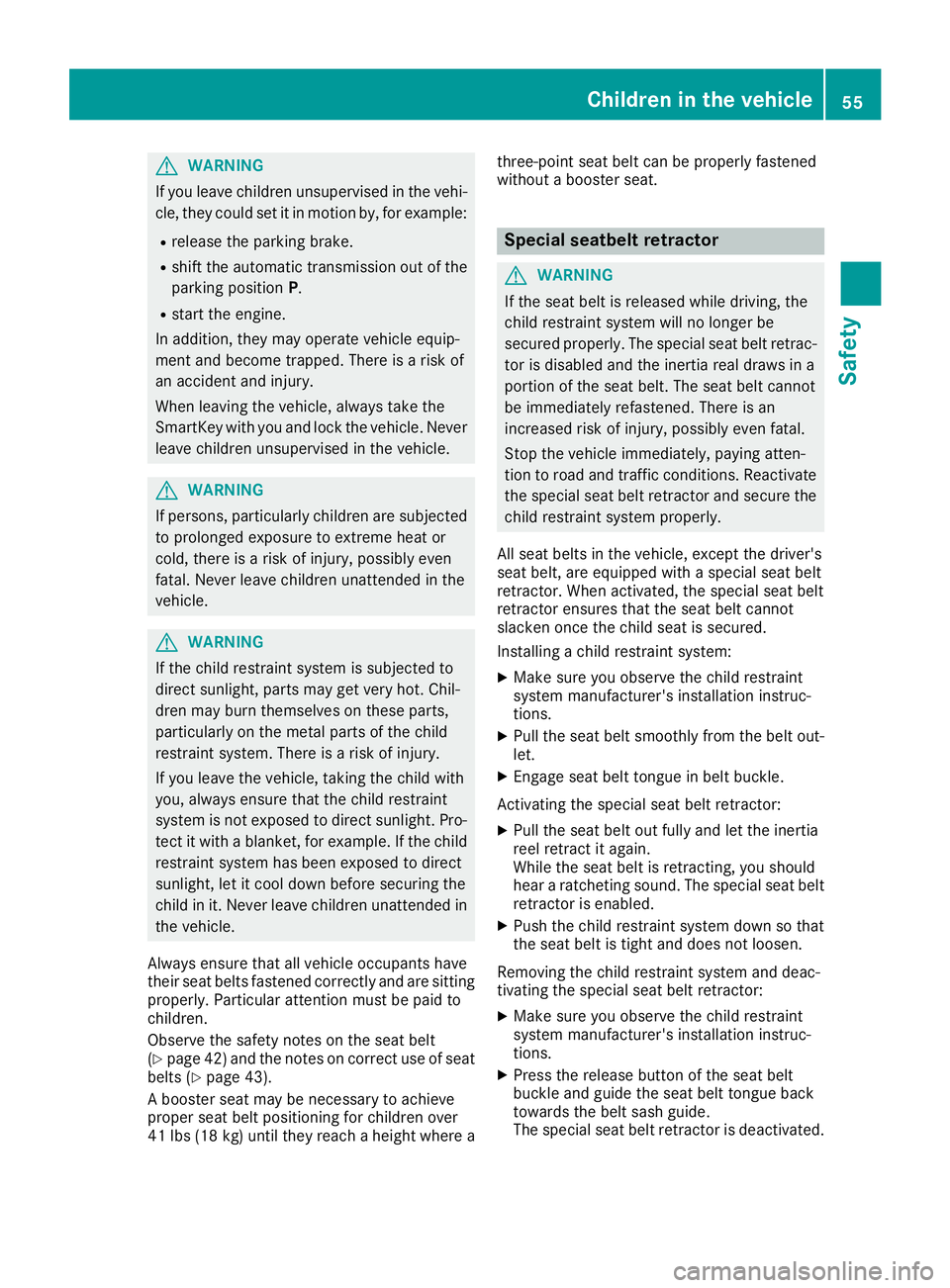
GWARNING
If you leave children unsupervised in the vehi-
cle, they coul dset it in motion by, for example:
Rrelease the parking brake.
Rshift the automatic transmission out of the
parking position P.
Rstart the engine.
In addition, they may operate vehiclee quip-
ment and become trapped. There is arisk of
an accident and injury.
When leaving the vehicle, alway stake the
SmartKey with you and lock the vehicle. Never
leave children unsupervised in the vehicle.
GWARNING
If persons, particularl ychildren are subjected
to prolonged exposure to extreme heato r
cold, there is arisk of injury ,possibly even
fatal .Never leave children unattended in the
vehicle.
GWARNING
If the child restraint system is subjected to
direct sunlight, parts may get very hot. Chil-
dren may burn themselves on these parts,
particularl yonthe metal parts of the child
restraint system. There is arisk of injury.
If you leave the vehicle, taking the child with
you ,alway sensure that the child restraint
system is not exposedtod irect sunlight. Pro-
tect it with ablanket, for example. If the child
restraint system has been exposedtod irect
sunlight, let it cool downb efore securing the
child in it. Never leave children unattended in
the vehicle.
Always ensure that all vehicleo ccupants have
their seat belts fastened correctly and are sitting
properly.P articular attention must be pai dto
children.
Observe the safety notes on the seat belt
(
Ypage4 2) and the notes on correct use of seat
belts (Ypage4 3).
Ab ooster seat may be necessary to achieve
propers eat beltp ositioning for children over
41 lbs (18 kg )until they reach aheight where a three-point seat beltc
an be properly fastened
without abooster seat.
Special seatbelt retractor
GWARNING
If the seat beltisr eleased while driving, the
child restraint system wil lnolonger be
secure dproperly.T he special seat beltr etrac-
tor is disableda nd the inertia real draw sina
portion of the seat belt. The seat beltc annot
be immediatel yrefastened. There is an
increased risk of injury ,possibly even fatal.
Stop the vehiclei mmediately, paying atten-
tion to road and traffic conditions. Reactivate
the special seat beltr etractor and secure the
child restraint system properly.
All seat belts in the vehicle, except the driver's
seat belt, are equipped with aspecial seat belt
retractor. When activated, the special seat belt
retractor ensure sthat the seat beltc annot
slacken once the child seat is secured.
Installing achild restraint system:
XMake sure you observe the child restraint
system manufacturer's installation instruc-
tions.
XPul lthe seat belts moothly from the belto ut-
let.
XEngage seat beltt ongue in beltbuckle.
Activating the special seat beltr etractor:
XPullthe seat belto ut fullyand let the inertia
reel retract it again.
Whilet he seat beltisr etracting, you should
hear aratcheting sound .The special seat belt
retractor is enabled.
XPush the child restraint system downsot hat
the seat beltist ight and does not loosen.
Removing the child restraint system and deac-
tivating the special seat beltr etractor:
XMake sure you observe the child restraint
system manufacturer's installation instruc-
tions.
XPress the release button of the seat belt
buckle and guide the seat beltt ongue back
toward sthe belts ash guide.
The special seat beltr etractor is deactivated.
Children in the vehicle55
Safety
Z
Page 58 of 326
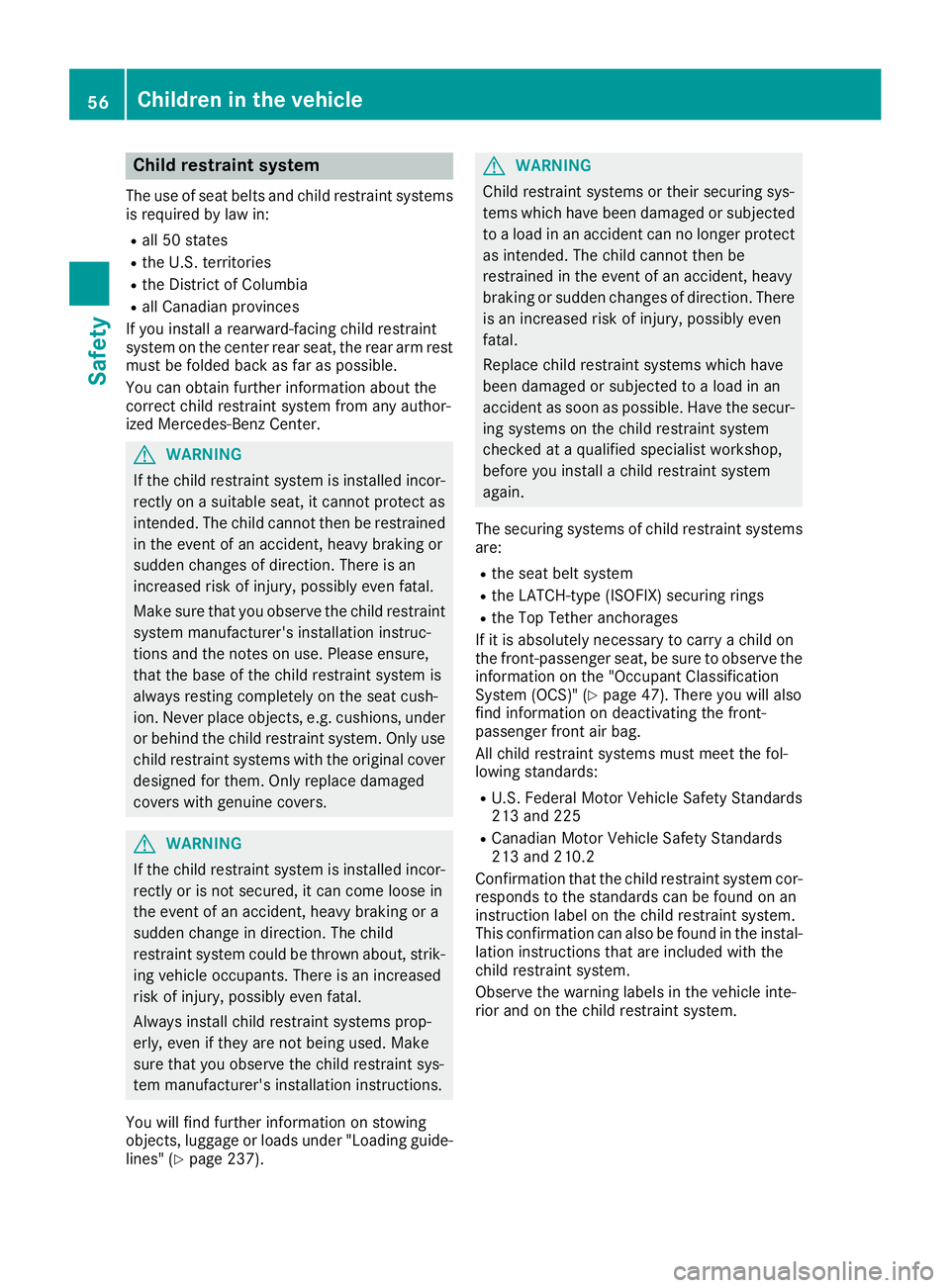
Child restraint system
The use of seat beltsand child restraint systems
is required by law in:
Rall 50 states
Rth eU .S.t erri tories
RtheD istrict of Columbia
Rall Canadian provinces
If you install arearward-facing child restraint
system on th ecente rrear seat,t herear arm rest
must be folded back as far as possible.
You can obtain further informatio nabout the
correc tchild restraint system from any author-
ize dM ercedes-Ben zCenter.
GWARNING
If th echild restraint system is installed incor-
rectly on asuitable seat,itc annotprotect as
intended. The child canno tthe nber estrained
in th eevent of an accident, heavyb raking or
suddenc hanges of direction.T hereisan
increased ris kofinjury, possibly eve nfatal.
Makes ure that you observ ethe child restraint
system manufacturer'si nstallationinstruc-
tions and th enotes on use. Pleasee nsure,
that th ebase of th echild restraint system is
always restin gcompletely on th eseat cush-
ion.N ever placeo bjects, e.g.cushions, under
or behindt hechild restraint system. Only use
child restraint systems witht heoriginal cover
designe dfor them. Only replace damaged
covers withg enuine covers.
GWARNING
If th echild restraint system is installed incor-
rectly or is no tsecured, it can com eloosei n
th ee vent of an accident, heavyb raking or a
suddenc hang eind irection.T he child
restraint system coul dbethrown about,s trik-
ing vehicle occupants. Thereisani ncreased
ris kofi njury, possibly eve nfatal.
Always install child restraint systems prop-
erly, eve niftheya re no tbeingu sed. Make
sure that you observ ethe child restraint sys-
te mm anufacturer'si nstallationinstructions.
You will fin dfurther informatio nonstowing
objects, luggageorl oads under"Loading guide-
lines" (
Ypage 237).
GWARNING
Child restraint systems or their securin gsys-
tems whichh ave been damaged or subjected
to aload in an accidentc an no longer protect
as intended. The child canno tthe nb e
restraine dintheevent of an accident, heavy
braking or suddenc hanges of direction.T here
is an increased ris kofinjury, possibly even
fatal.
Replacec hild restraint systems whichh ave
been damaged or subjected to aload in an
accidentass oon as possible. Hav ethe secur-
ing systems on th echild restraint system
checked at aqualified specialist workshop,
before you install achild restraint system
again.
The securin gsystems of child restraint systems
are:
Rth es eat belt system
RtheL ATCH-type (ISOFIX) securin grings
RtheT op Tether anchorages
If it is absolutely necessary to carry achild on
th ef ront-pa ssenger seat,bes ure to observethe
informatio nonthe"Occupan tClassification
Syste m(OCS)" (
Ypage 47) .Therey ou will also
fin dinformatio nondeactivatin gthe front-
passenger fronta ir bag.
All child restraint systems must mee tthe fol-
lowings tandards:
RU.S. Federal Motor Vehicle SafetyS tandards
21 3a nd 225
RCanadian Motor Vehicle SafetyS tandards
21 3a nd 210.2
Confirmation that th echild restraint system cor-
responds to th estandards can be foun donan
ins truc
tion label on th
echild restraint system.
This confirmation can also be foun dintheinstal-
lation instructionst hata re included witht he
child restraint system.
Observ ethe warning labels in th evehicle inte-
rior and on th echild restraint system.
56Children in th evehicle
Safety
Page 59 of 326

LATCH-type(ISOFIX) child seat secur-
ing system
GWARNING
LATCH-type (ISOFIX) child restraint systems
do not offer sufficient protection for children
whose weight combine dwith th echild
restraint system is greater than 65 lbs (29 kg) and who are secured usingt hesafety belt
integrated in th echild restraint system. In the
even tofana ccident, achild mightn ot be
restrained correctly. This poses an increased
risk of injury or even fatal injury.
If th echild and th echild restraint system
together weigh moret han65l bs (29 kg), only
use LATCH-type (ISOFIX) child restraint sys-
tem swith whicht hechild is also secured with
th ev ehicle seat belt.A lsos ecure th echild
restraint system with th eTop Tether belt,i f
available.
Always comply with th emanufacturer' sinstal-
latio nand operatin ginstructionsf or thechild
restraint system used.
Before ever ytrip, makes ure that th eLATCH-
type (ISOFIX) child restraint system is engaged
correctly in bothL ATCH-type (ISOFIX) securing
rings
!When installing th echild restraint system,
makes ure that th eseat belt for th emiddle
seat does not get trapped. The seat belt could otherwise be damaged.
XInstall th eLATCH-type (ISOFIX) child restraint
system on bothL ATCH-type (ISOFIX) securing
rings :.
ISOFI Xisas tandardized securings ystem for
specially designed child restraint systems on
th er ear seats. LATCH-type (ISOFIX) securing rings for two LATCH-type (ISOFIX) child restraint
systems are installe
dontheleft and rightoft he
rear seats.
Non-LATCH-type (ISOFIX) child seatsm ay also
be used and can be installe dusingt hevehicle's
seat belt system. Install th echild seat according
to th emanufacturer' sinstructions.
Top Tether
Introduction
Top Tether provides an additional connection
between th echild restraint system secured with
aL ATCH-type (ISOFIX) system and th evehicle.
This helps reducet herisk of injury even further.
If th echild restraint system is equipped with a
Top Tether belt,t hiss hould always be used.
Important safety notes
GWARNING
If th erear seat backrests are not locked ,the y
could fold forwards in th eeventofana cci-
dent, heavy braking or sudden changes of
direction. As aresult, child restraint systems
cannot perform their intended protective
function.R ear seat backrests that are not
locked can also cause additional injuries,e .g.
in th eeventofana ccident. This poses an
increased risk of injury or even fatal injury.
Always lock rear seat backrests after instal-
ling aTop Tether belt.O bserve thelockv eri-
ficatio nindicator. Adjust th erear seat backr-
estssot hatthe ya re in an uprightp osition.
If th erear backrestisn ot engaged and locked,
th er ed lock verificatio nindicator will be visible
(
Ypage 240).
Children in th evehicle57
Safety
Z
Page 60 of 326

Top Tether anchorages
The TopTethera nchorage points ar einstalle din
the rea rcompartment behind the head
restraints on the parcel shelf.
XPress down the rea rofcover;in the direc-
tio noft he arrow.
Cover ;is raised slightlyatt he front.
XFoldc over ;up.
Vehicle switha djustabl eheadr estraints:
XMov eheadr estraint :up.
XRoute To pTetherb eltA under head
restraint :between the two head restraint
bars.
Vehicle swithout adjustabl eheadr estraints:
XTop Tether belt with on ebelts trap: route
To pT etherb eltA centrall yoverh ead
restraint :.
or
XTop Tether belt with two belt straps: route
one To pTetherb eltA to the left and one to
the right past the side of head restraint :.
Al lv eh icles:
XInstall the LATCH-type (ISOFIX)c hild restraint
system with To pTether. Alway scomply with the child restraint system manufacturer's
installatio
ninstructions when doing so.
XHookT opTetherh ook?of To pTetherb elt
A into To pTethera nchorage =.
Make sure that:
RTo pT etherh ook?is hooked into Top
Tethera nchorage =as shown.
RTopT etherb eltA is not twisted.
RTopT etherb eltA is routed between the
rea rseatb ackres tand the cargo compart-
ment cove rifthe cargo compartment cover
is installed.
XTension To pTetherb eltA.A lwayscomply
with the child restraint system manufactur-
er' sinstallatio ninstructions when doing so.
Vehicle switha djustabl eheadr estraints:
XIf necessary,m oveh eadr estraint :back
down agai nsligh tly.M akes uret haty oudo
not interfere with the correct routing of Top
Tetherb eltA.
Chil drestrain tsystem on the front-
passenge rseat
General notes
Accident statistics sho wthatc hildren secured
in the rea rseats ar esafer thanc hildren secured
in the front-passenge rseat. For thisr eason,
Mercedes-Benz strongl yadvises thaty ouinstall
the child restraint system on arears eat.
If it is absolutely necessary to instal lachild
restraint system on the front-passenge rseat,
always observe the instructions and safety
note sont he "Occupant Classification System
(OCS) "(
Ypage 47).
Yo uc an thusa voidthe risks thatc ould ariseas
ar esul tof:
Ran incorrectly categorize dpersonint he front-
passenge rseat
Rthe unintentiona ldeactivatio nofthe front-
passenge rfront ai rbag
Rthe unsuitable positioning of the child
restraint system ,e.g.t oo close to the dash-
board
58Children in the vehicle
Safety